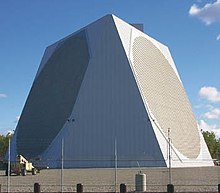
Back Сістэма папярэджання аб ракетным нападзе Byelorussian Radar včasné výstrahy Czech Radar d'alerte précoce French Radar peringatan dini ID 早期警戒レーダー Japanese 조기경보레이더 Korean Radar amaran awal Malay Tidligvarslingradar NB Система предупреждения о ракетном нападении Russian Система попередження про ракетний напад Ukrainian
This article needs additional citations for verification. (April 2023) |

An early-warning radar is any radar system used primarily for the long-range detection of its targets, i.e., allowing defences to be alerted as early as possible before the intruder reaches its target, giving the air defences the maximum time in which to operate. This contrasts with systems used primarily for tracking or gun laying, which tend to offer shorter ranges but offer much higher accuracy.
EW radars tend to share a number of design features that improve their performance in the role. For instance, EW radar typically operates at lower frequencies, and thus longer wavelengths, than other types. This greatly reduces their interaction with rain and snow in the air, and therefore improves their performance in the long-range role where their coverage area will often include precipitation. This also has the side-effect of lowering their optical resolution, but this is not important in this role. Likewise, EW radars often use much lower pulse repetition frequency to maximize their range, at the cost of signal strength, and offset this with long pulse widths, which increases the signal at the cost of lowering range resolution.
The canonical EW radar is the British Chain Home system, which entered full-time service in 1938. It used a very low pulse repetition of 25 pps and very powerful transmissions (for the era) reaching 1 MW in late-war upgrades. The German Freya and US CXAM (Navy) and SCR-270 (Army) were similar. Post-war models moved to the microwave range in ever-increasingly powerful models that reached the 50 MW range by the 1960s. Since then, improvements in receiver electronics has greatly reduced the amount of signal needed to produce an accurate image, and in modern examples the transmitted power is much less; the AN/FPS-117 offers 250 nautical miles (460 km; 290 mi) range from 25 kW. EW radars are also highly susceptible to radar jamming and often include advanced frequency hopping systems to reduce this problem.